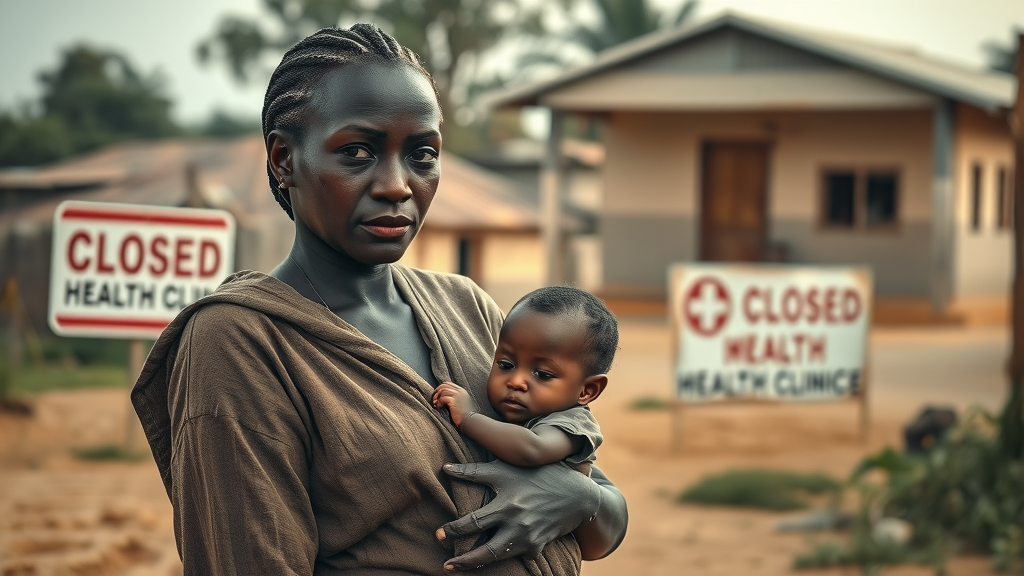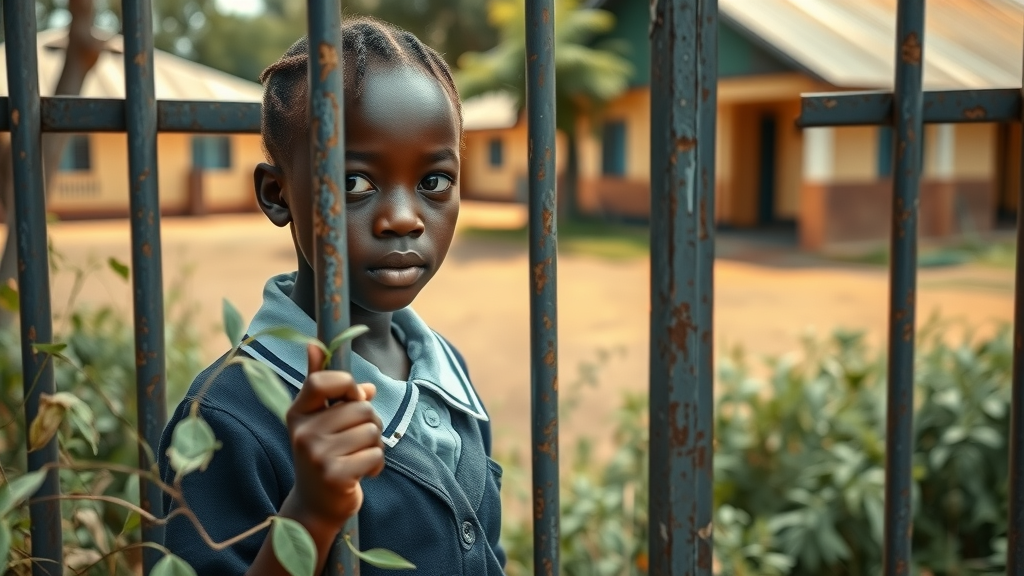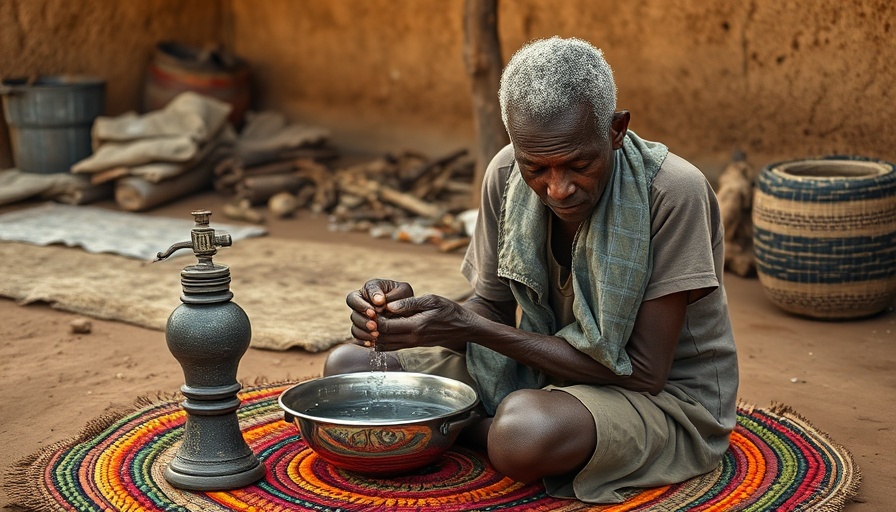Every year, UK foreign aid once shielded over seven million African women from unsafe births and supported the education of millions of children. But with a sudden 40% slash in funding, life-changing programs are vanishing overnight.
This article uncovers how the UK’s drastic reduction in foreign aid—particularly for women’s health and children’s education in Africa—will affect millions for generations to come. The consequences stretch far beyond budget sheets: we’re witnessing a turning point for basic health, girls' schooling, and regional stability.
Startling Realities: What the 40% UK Cut to Foreign Aid Means for Africa's Women and Children
The United Kingdom’s decision to cut foreign aid by 40% has sent shockwaves through Africa, where countless families depend on UK-backed initiatives for survival and a chance at a better future. The foreign aid cuts specifically target women’s health programs and children’s education, leaving some of the most vulnerable without lifelines. According to recent impact assessments , immediate fallout includes shuttered health clinics, cancelled immunization drives, and the abrupt end to scholarships for girls in marginalized communities.
Millions of African women will now be denied access to basic reproductive health services, with a direct increase in disease and death as clinics close and essential medicines run out. Meanwhile, the aid cut is shuttering classrooms and teacher salaries, threatening to reverse decades of educational progress in rural regions stretching from South Sudan to Mozambique. These figures, reported by organizations like UNICEF and the World Bank, underscore the deep reliance African societies have on stable and predictable aid flows from major donors like the UK.
The 40% decrease is not just a number; it's a generational setback for the entire continent. As humanitarian support shrinks, bridges to a healthier, more educated future collapse. For many, the threat isn’t just lost opportunity; it is the very real risk of falling back into cycles of poverty, instability, and untold suffering.

A Look at the Numbers: How the UK’s 40% Foreign Aid Cut Measures Up Globally
The UK has historically been one of the world’s largest providers of foreign aid , with annual contributions surpassing billions of pounds and focusing on sectors like gender programming, humanitarian support, and education. However, the 40% reduction places the UK’s aid budget far below its peers in the G7 and lower than its former commitment of 0.7% of gross national income to overseas aid. The scale of these cuts has stunned the global development community.
According to the World Bank and the International Development Association, this is one of the biggest reductions in any G7 nation’s aid spending this decade. Compared to EU counterparts and Canada, the UK’s plans to cut foreign aid have resulted in the withdrawal from multilateral organisations and support for children 's vaccine programs through the Vaccine Alliance. Figures show that targeted support for marginalized communities—once a hallmark of UK generosity—has been reduced, straining efforts to combat global crises.
"The reduction in UK foreign aid is projected to leave 7 million women without access to reproductive health services and millions of children at risk of missing out on basic education." – UNICEF Report 2024
Understanding the UK’s Decision: Why Cut Foreign Aid At This Scale?
The justification for slashing foreign aid by 40% has roots in both domestic political pressures and economic realities . Amid growing public scrutiny over aid spending and moves to increase defence spending , the UK government prioritized national interests—such as its commitment to defence spending —over international development. The COVID-19 pandemic’s impact on the UK economy forced budget recalculations, leading the government to temporarily reduce foreign aid from 0.7% to 0.5% of gross national income.
Officials within the Foreign Office and the Treasury have justified the move by pointing to fiscal deficits and competing priorities. Yet, policy experts like Gideon Rabinowitz argue the cut is not just a temporary adjustment, but a significant shift in the UK’s approach to its global role. Plans to cut foreign aid have been criticized for lacking transparent impact assessment, raising concerns about accountability and the true rationale behind these decisions.
In the broader context of international development, abandoning long-standing commitments jeopardizes relationships with partner countries and multilateral organizations. Many experts view this move as a departure from the UK’s legacy of compassionate foreign policy.
Political and Economic Context Behind the UK Aid Cut
Navigating unprecedented economic challenges—including post-pandemic recovery costs and inflation—the UK government faced mounting pressure to optimize every pound of public spending. As a result, leaders in Westminster, often guided by public opinion and party manifesto pledges, deemed foreign aid an area for significant reduction. The decision saw billions reallocated from international development to domestic priorities and defense.
Some proponents defend the aid cut as a means to restore the UK’s own economy, citing national income constraints. However, leading NGOs and development analysts argue that austerity measures do not justify dismantling decades of progress for the world’s poorest. Diminished foreign aid spending risks eroding the UK’s soft power and undermining the principle of global solidarity.

The UK’s Foreign Aid Commitments: A Timeline of Shifting Priorities
To understand the scale of this foreign aid cut, it’s essential to consider the timeline of the UK’s aid commitments. Since the International Development Act 2002, the UK established itself as a leader in global aid, reaching 0.7% of gross national income for overseas development in 2013. This commitment endured until 2020, when pandemic fallout led to the first major reduction. Over the past three years, aid spending shrank and targeted programs for education and women experienced the most drastic budget cuts.
Recent years have also seen the UK withdraw from or reduce contributions to key multilateral organizations like the World Bank and the International Development Association. The government’s changing priorities are evident in new policies, shifting from humanitarian support abroad to increased focus on national initiatives.
| Year | Major Decision | Key Sectors Affected |
|---|---|---|
| 2013-2020 | Maintained 0.7% GNI on foreign aid | Education, healthcare, gender programming, humanitarian |
| 2020 | Cut to 0.5% GNI due to pandemic | Health, childhood vaccinations, girls’ education |
| 2022 | Further reduction & withdrawal from projects | Reproductive health, social protection, food assistance |
| 2023 | 40% aid cut finalized in annual budget | Maternal health, school building, teacher training |
Immediate Impact of the Foreign Aid Cut on Women’s Health in Africa
For women across Africa, UK aid has meant life-saving access to maternal healthcare, prenatal check-ups, contraception, and protection from preventable diseases. With the UK cutting its foreign aid by 40% , many of these clinics and outreach programs have closed or are on the brink of collapse. According to local health ministries and NGOs operating in South Sudan and the Sahel, maternal and child health sectors are now critically underfunded.
Before the aid cut , the UK funded programs targeting maternal mortality, the prevention of transmission of diseases such as HIV and malaria, and child nutrition initiatives. As donor support wanes, the ripple effect means increased rates of unsafe deliveries, higher prevalence of untreated diseases, and more deaths from otherwise preventable causes. The situation is exacerbated in rural and marginalized areas, where UK funding once closed major gaps left by national budgets.
Maternal Health Programs at Risk: Facts and Projections
The reality for African mothers is stark. The sudden aid reduction has caused a 15% rise in unsafe births in regions where UK support kept clinics well-equipped and staffed. Maternal health programs, vital for reducing complications during pregnancy and childbirth, are already recording rising rates of disease and death. Figures show that outreach visits and routine medical supplies—once consistently funded by foreign aid—have been interrupted or stopped entirely.
Impact assessments by both NGOs and the World Bank warn of a significant backslide in progress made over the last decade. Without the UK’s planned contributions, countries are struggling to maintain basic services, let alone meet Sustainable Development Goals for women’s health in Africa. The loss of UK aid will likely double the maternal mortality rate in some of the hardest-hit countries.
Family Planning and Reproductive Services: What Happens After Aid Cutbacks?
Of all the sectors hit, family planning and reproductive health face some of the most devastating cutbacks. Programs providing contraception, safe abortion access, and reproductive health education relied heavily on foreign aid spending from the UK. Now, women and adolescent girls encounter long waits, travel great distances, or pay unaffordable prices for basic care—if they can find it at all.
The Vaccine Alliance and other multilateral bodies have warned that ending these programs will cause increases in unwanted pregnancies, unsafe abortions, and higher rates of reproductive tract infections. In the long-term, the reduction of aid funding leads to higher healthcare costs for governments and diminished prospects for women and girls, trapping many in cycles of poverty and poor health.
"When aid is cut, essential services like maternal clinics close. We've already seen a 15% increase in unsafe births in some African regions." – Médecins Sans Frontières

Education Interrupted: How the Aid Cut Impacts Children’s Learning in Africa
Foreign aid from the UK has long underpinned efforts to increase school enrollment, train teachers, and provide safe learning environments for Africa’s children—especially girls and those in marginalized communities. With a 40% aid cut , entire education systems face collapse. School closures, canceled programs, and salary reductions threaten to undo the progress painstakingly built over decades.
For millions of students, especially in rural parts of Africa, UK aid meant the difference between attending school and a lifetime of illiteracy. Education advocates warn that the sudden loss of funding is already resulting in ballooning dropout rates, larger class sizes, and reduced access to materials and critical infrastructure like clean water and electricity in schools.
Classroom Closures and Cutbacks: A Statistical Profile
The ripple effects are evident on the ground. Since the aid cut , hundreds of schools have closed and thousands of teaching positions have been left unfilled, particularly in countries heavily dependent on external support like South Sudan and Sierra Leone. Figures show that in some regions, enrollment has dropped by over 20%, erasing years of hard-won gains.
The abrupt end to UK-backed scholarships and feeding programs further compounds the problem, keeping the poorest children—especially girls—out of school. The risk is particularly acute in fragile states where education and humanitarian support are closely intertwined in keeping communities stable.

Girls’ Access to Education After the UK Cuts Foreign Aid by 40%
Girls are disproportionately affected by the UK’s foreign aid cut . Many programs targeted gender disparities, helping girls stay in school, avoid early marriage, and achieve higher education. Without this aid, dropout rates for girls are spiking, and essential services like sanitary pad distribution, mentorship, and safety initiatives are vanishing.
The UK once funded pilot projects that saw girls in remote villages become the first in their families to read and write. Now, parents face impossible choices: keep daughters at home to care for siblings or send them to riskier schools farther away. The cumulative effect is a widening gap in gender equality, shrinking the life chances of the next generation.
- Community school construction projects halted mid-way
- Teacher training and curriculum development programs canceled
- Nutrition and school feeding initiatives defunded
- Safe spaces and scholarships for girls discontinued
- Educational materials, including textbooks and digital tools, in severe shortage
What You’ll Learn from the UK’s 40% Foreign Aid Cut: A Summary
- The UK’s 40% cut to foreign aid is one of the sharpest in recent memory, affecting millions in Africa.
- Women’s health and reproductive services face the immediate risk of collapse.
- Children’s education—especially for girls and marginalized communities—has been drastically disrupted.
- Broader stability and health security in Africa are at risk due to reduced humanitarian support.
- The decision reflects shifting UK political and economic priorities, with global implications for foreign aid policy.
Examining the Broader Impact: Instability, Health Insecurity, and Migration
The cuts to UK foreign aid extend well beyond individual lives; they threaten to destabilize entire regions. When households lose access to health and education, communities suffer, and local economies weaken. Humanitarian support that once provided a safety net in times of conflict or disaster is now insufficient, leaving populations more vulnerable to exploitation, disease, and forced migration.
Marginalised communities often rely exclusively on foreign aid, making them especially susceptible to the negative effects of abrupt funding withdrawals. Analysts warn of a vicious cycle: as health and education systems weaken, social and political instability rise, fueling displacement and migration, with downstream impacts even outside of Africa.
How Slashed Foreign Aid Fuels Vulnerability and Instability
Aid cuts create gaps that local governments and economies cannot quickly fill. As hospitals and schools close, more families are forced to move in search of stability, leading to internal displacement and cross-border migration. Contagion risks for diseases untreated in one country can quickly spread regionally, overwhelming neighboring health systems.
Long-term, this fragility weakens economic prospects, deters investment, and can sow the seeds of prolonged instability or the resurgence of conflict, as seen in countries like South Sudan . The World Bank cautions that regional crises become harder to contain without robust international development and aid spending.

Aid Cut and Long-Term Effects on African Economies
The reduction in UK aid dollars reverberates throughout African economies, touching nearly every sector linked to international development. When major donors scale back, job losses occur in health and education, supply chains for medical supplies and learning materials are interrupted, and local non-profits working on the ground are forced to close or lay off staff.
Reduced external funding means African governments must stretch already thin budgets to fill the gaps, risking other crucial services like water, sanitation, and infrastructure. Over the years, sustained cuts can undermine the foundations of growth and productivity. In the words of seasoned development association leaders, “No nation can afford to ignore the chaos of collapsed education and health systems beyond its borders.”
Is Cutting Foreign Aid a False Economy? Opinions and Calls for Change
Critics argue that cutting foreign aid is, ultimately, a short-sighted policy . The costs of inaction—higher rates of disease and death , increased migration, instability, and greater barriers to global trade—far outweigh the immediate budget savings. The aid cut erodes the UK’s global leadership and reputation as a force for good, raising questions about the country’s role in international development for years to come.
Calls for change are growing louder. Policy experts and affected communities urge the UK government to reconsider plans to cut foreign aid and restore support for education and women’s health in Africa. Many believe meaningful international security and prosperity cannot be achieved through isolation—a point regularly echoed by multilateral organizations and the Foreign Office alike.
"No nation can afford to ignore the chaos of collapsed education and health systems beyond its borders." – Professor Fiona Williams, Development Policy Expert
People Also Ask: Answers to the Top Questions About the UK Foreign Aid Cut
Why did the United Kingdom cut foreign aid by 40%?
The UK government implemented the 40% foreign aid cut to address domestic budgetary pressures following the economic impact of the COVID-19 pandemic. Leaders wanted to prioritize national spending, including increased funding for defense, over international development commitments. While supporters of the cut cite fiscal necessity, critics argue it undermines long-term stability and humanitarian progress abroad, particularly in African nations dependent on UK support.
What programs are most affected by the UK slashing support for women’s health and children’s education in Africa?
Maternal health clinics, family planning services, childhood vaccination initiatives, girls’ scholarships, school building projects, and teacher training programs are among the most affected. The UK’s foreign aid once covered gaps that local governments couldn’t fill, especially in rural and marginalized communities. With the aid cut , many of these critical services have been eliminated or severely reduced, impacting millions of lives.
What are the long-term effects on women’s health after foreign aid is cut?
Long-term, the lack of foreign aid increases maternal mortality, limits access to skilled birth attendants, and reduces women’s ability to make informed reproductive choices. This reverses years of progress in women’s health in Africa, leading to higher national health costs, more vulnerable populations, and perpetuating cycles of poverty and poor health outcomes for future generations.
How does the foreign aid cut affect children’s education in Africa?
The most immediate effects include school closures, the loss of scholarships, decreased attendance (especially among girls), and reduced resources for teaching and learning. Over time, the cut in support for children compounds educational inequality and reduces the continent’s human capital, making economic development and poverty eradication even harder to achieve.
Frequently Asked Questions on the UK’s Foreign Aid Cut and Global Development
- Does most foreign aid go to corrupt governments? No, the majority of UK aid is distributed through NGOs, multilateral agencies, and monitored programs, reducing the risk of misuse.
- Is foreign aid wasted on ineffective programs? While some inefficiency exists in all sectors, most foreign aid delivers life-changing services in health, education, and food security for millions.
- Can private donations replace foreign aid? Philanthropy is important but cannot match the scale or coordination of government aid funding for sustained development.
- Is reducing foreign aid popular in the UK? Polls show mixed opinions, but many Britons support aid when they understand its impact on global health and prosperity.
Summing Up: The Far-Reaching Effects of the UK Cutting Foreign Aid by 40%
Restoring and protecting UK foreign aid is critical—not just ethically but strategically—for long-term global health, education, and stability. Every pound cut today could cost lives and opportunities for decades.

 Add Row
Add Row  Add
Add 


Write A Comment